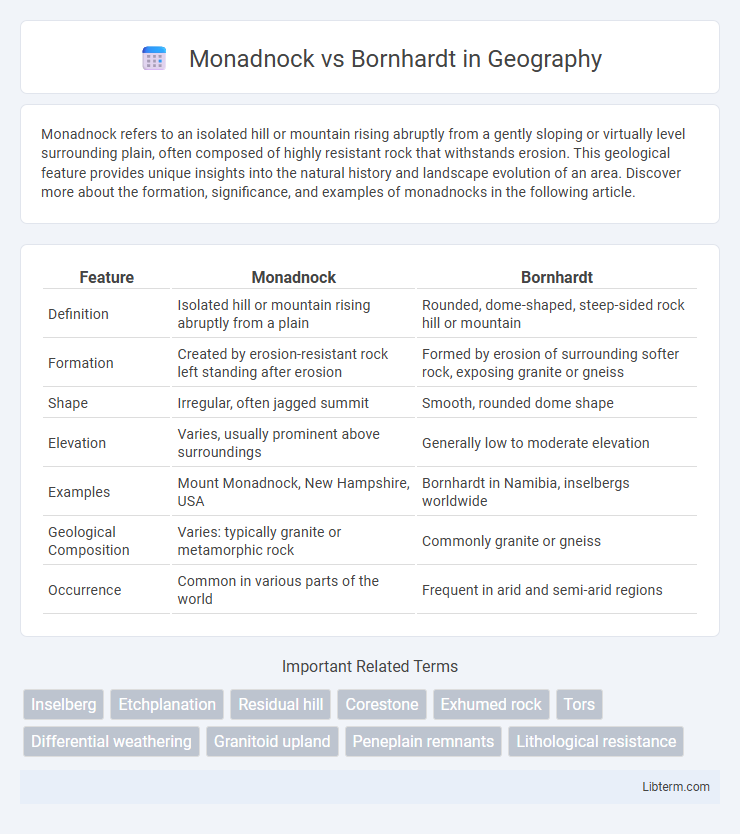Monadnock refers to an isolated hill or mountain rising abruptly from a gently sloping or virtually level surrounding plain, often composed of highly resistant rock that withstands erosion. This geological feature provides unique insights into the natural history and landscape evolution of an area. Discover more about the formation, significance, and examples of monadnocks in the following article.
Table of Comparison
| Feature | Monadnock | Bornhardt |
|---|---|---|
| Definition | Isolated hill or mountain rising abruptly from a plain | Rounded, dome-shaped, steep-sided rock hill or mountain |
| Formation | Created by erosion-resistant rock left standing after erosion | Formed by erosion of surrounding softer rock, exposing granite or gneiss |
| Shape | Irregular, often jagged summit | Smooth, rounded dome shape |
| Elevation | Varies, usually prominent above surroundings | Generally low to moderate elevation |
| Examples | Mount Monadnock, New Hampshire, USA | Bornhardt in Namibia, inselbergs worldwide |
| Geological Composition | Varies: typically granite or metamorphic rock | Commonly granite or gneiss |
| Occurrence | Common in various parts of the world | Frequent in arid and semi-arid regions |
Introduction to Monadnock and Bornhardt
Monadnocks are isolated hills or mountains made of hard rock that rise abruptly from gently sloping or flat surrounding terrain, formed through long-term erosion processes. Bornhardts are dome-shaped, steep-sided rock formations composed primarily of granitic or metamorphic rock, characterized by their smooth, rounded surfaces. Both geological features serve as prominent landmarks, with monadnocks typically representing remnants of ancient landscapes and bornhardts indicating resistance to weathering.
Defining Monadnock: Characteristics and Origin
A monadnock is an isolated hill or mountain rising abruptly from a gently sloping or virtually level surrounding plain, typically composed of resistant rock that withstands erosion. These landforms originate from long-term weathering processes where softer surrounding rocks erode away, leaving the harder rock exposed. Monadnocks often serve as prominent landmarks due to their solitary, steep-sided appearance contrasting with the flat terrain.
Understanding Bornhardt: Key Features and Formation
Bornhardts are isolated, dome-shaped rock formations primarily composed of hard, resistant granite or sandstone, characterized by their smooth, rounded surfaces and steep sides. They form through a combination of chemical weathering and exfoliation, where the outer rock layers peel away due to temperature fluctuations and pressure release. Unlike Monadnocks, which are remnants of erosion-resistant hills standing above surrounding landscapes, Bornhardts result specifically from differential weathering processes that expose underlying rock domes.
Geological Processes Behind Monadnock Creation
Monadnocks form through prolonged erosion that removes surrounding softer rocks, leaving a resistant rock mass exposed, typically composed of granite or quartzite. Bornhardts are dome-shaped, inselberg landforms created by exfoliation weathering and jointing in massive, homogenous rock bodies, often found in tropical regions. The geological processes behind monadnock formation emphasize differential weathering and tectonic uplift, whereas bornhardts result mainly from surface unloading and thermal expansion in stable cratons.
Formation Mechanisms of Bornhardt Landforms
Bornhardt landforms form through the processes of exfoliation and chemical weathering acting on massive, homogeneous rock types such as granite or quartzite, leading to dome-shaped, steep-sided hills. Bornhardts develop in tropical or subtropical climates where intense weathering causes jointed rock to peel off in sheets, contrasting with monadnocks, which are isolated residual hills formed primarily by differential erosion resistant to surrounding softer rock. These mechanisms result in bornhardts exhibiting smooth, rounded surfaces that reflect the subsurface rock structure and weathering patterns distinct from the more rugged, erosion-resistant monadnocks.
Similarities Between Monadnocks and Bornhardts
Monadnocks and bornhardts both represent prominent geological features formed by the differential erosion of surrounding softer rock, leaving behind isolated, resistant rock masses. Each exhibits a dome-shaped, smooth surface composed primarily of hard, igneous, or metamorphic rock that withstands weathering and erosion. Their formation processes highlight long-term geological stability and resistance to environmental factors shaping landscapes over millions of years.
Distinct Differences: Monadnock vs Bornhardt
Monadnocks are isolated hills or mountains composed of more resistant rock that have withstood erosion, often rising prominently above the surrounding terrain. Bornhardts are large, dome-shaped, steep-sided rock formations usually formed from massive, homogeneous rock types like granite, characterized by their smooth, rounded surfaces. The key difference lies in their scale and shape: monadnocks are typically smaller and more irregular in form, while bornhardts are larger, dome-like features with distinct geomorphological development.
Global Examples of Monadnocks and Bornhardts
Monadnocks, isolated hills rising abruptly from flat plains, include notable global examples such as Stone Mountain in Georgia, USA, and Sugarloaf Mountain in Rio de Janeiro, Brazil. Bornhardts, characterized by smooth, dome-shaped granite outcrops, are exemplified by Uluru (Ayers Rock) in Australia and Tsodilo Hills in Botswana. These distinct landforms showcase geological processes like differential erosion and granite intrusion in various climates worldwide.
Scientific Significance in Geomorphology
Monadnocks and bornhardts represent distinct geomorphological features that reveal critical insights into landscape evolution and weathering processes. Monadnocks, typically isolated hills composed of resistant rock, illustrate long-term erosion patterns and the differential durability of geological formations. Bornhardts, characterized by dome-shaped, steep-sided rock formations, provide valuable information on granitic rock exfoliation and chemical weathering in tropical and arid environments, enhancing understanding of crustal stability and surface dynamics.
Conclusion: Comparing Monadnock and Bornhardt
Monadnocks are isolated hills or mountains formed by erosion-resistant rock remaining after surrounding softer material has worn away, while bornhardts are dome-shaped, steep-sided rock formations typically composed of granite or gneiss. Both features illustrate different geological processes; monadnocks emphasize long-term erosion with significant height contrast, whereas bornhardts highlight chemical weathering shaping large rock domes. Understanding their differences aids geologists in analyzing landscape evolution, rock composition, and weathering patterns across various terrains.
Monadnock Infographic

 libterm.com
libterm.com